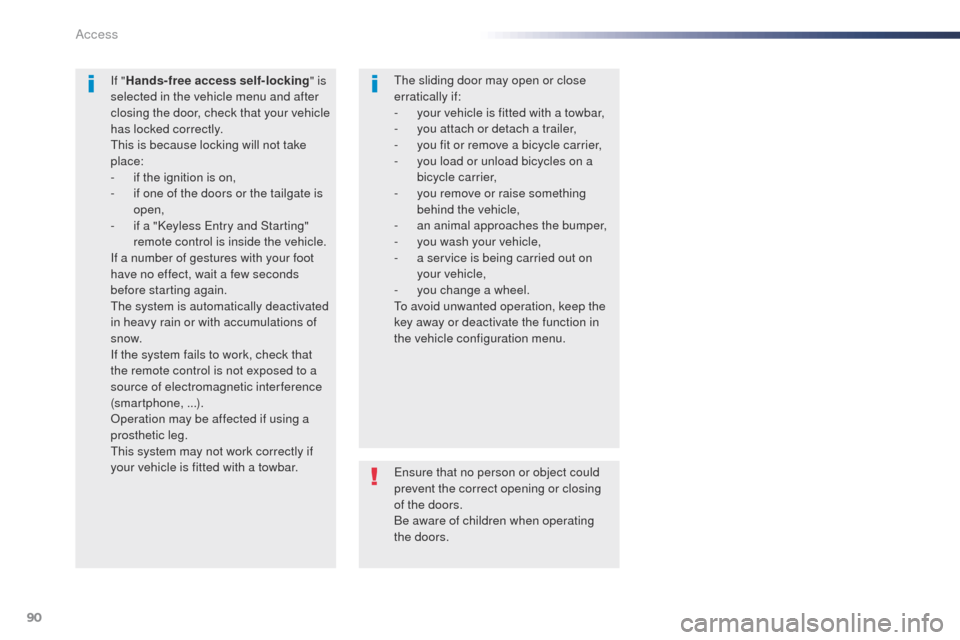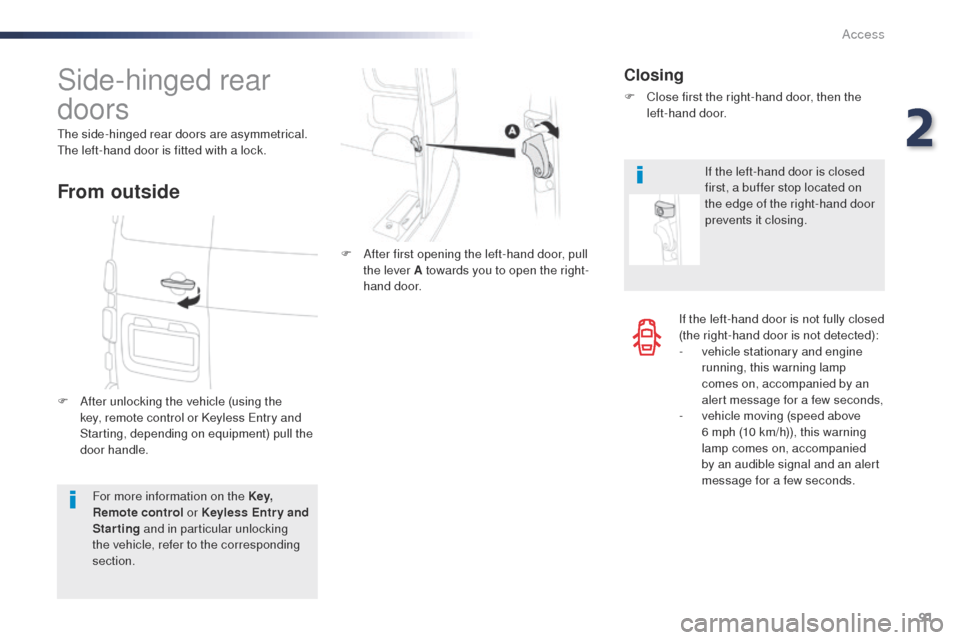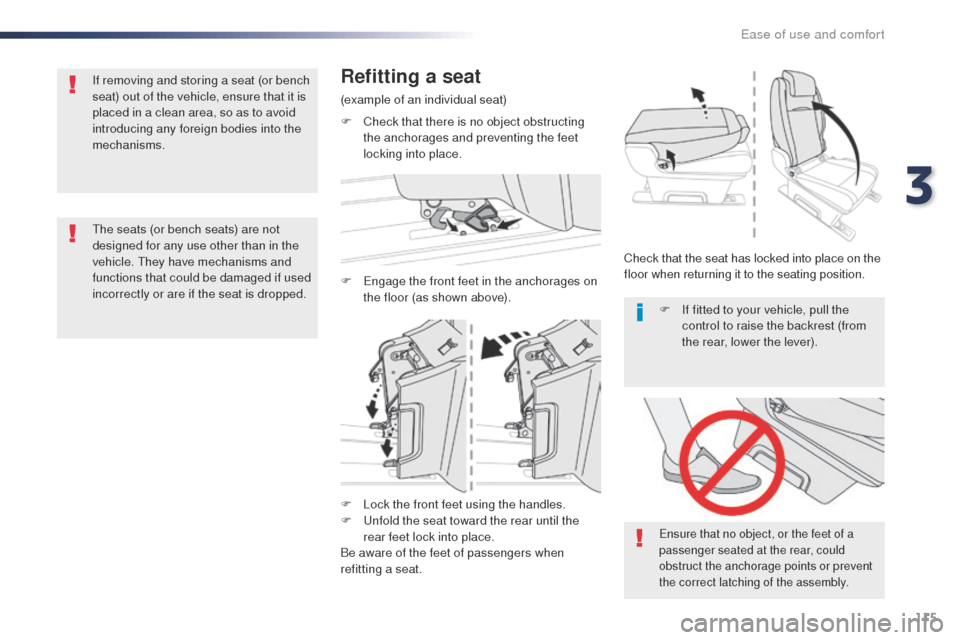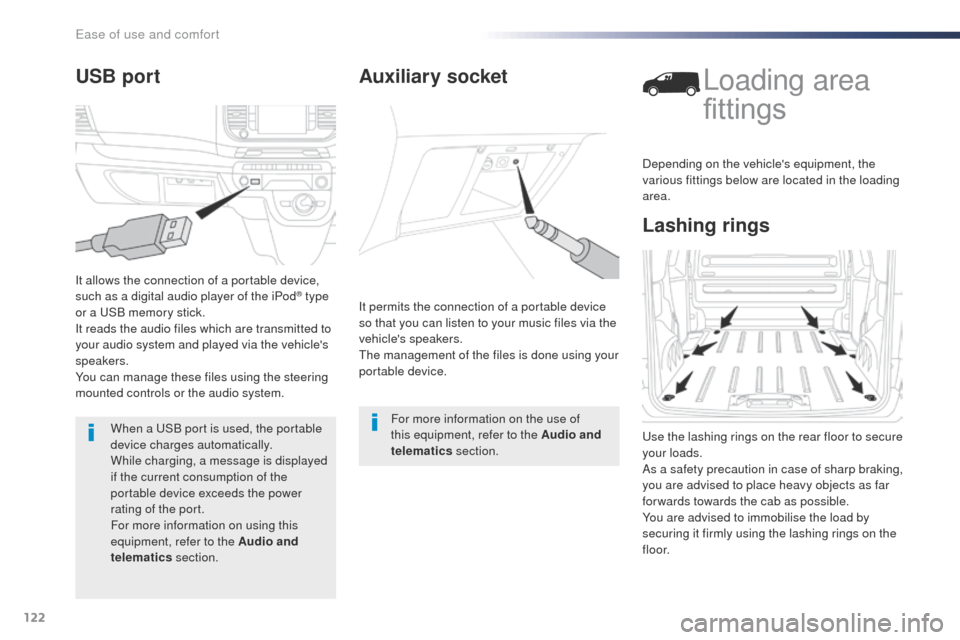Page 92 of 520

90
ensure that no person or object could
prevent the correct opening or closing
of the doors.
Be aware of children when operating
the doors.
If "
Hands-free access self-locking " is
selected in the vehicle menu and after
closing the door, check that your vehicle
has locked correctly.
th
is is because locking will not take
place:
-
i
f the ignition is on,
-
i
f one of the doors or the tailgate is
open,
-
i
f a "Keyless
e
n
try and Starting"
remote control is inside the vehicle.
If a number of gestures with your foot
have no effect, wait a few seconds
before starting again.
th
e system is automatically deactivated
in heavy rain or with accumulations of
snow.
If the system fails to work, check that
the remote control is not exposed to a
source of electromagnetic interference
(smar tphone, ...).
op
eration may be affected if using a
prosthetic leg.
th
is system may not work correctly if
your vehicle is fitted with a towbar.
th
e sliding door may open or close
erratically if:
-
y
our vehicle is fitted with a towbar,
-
y
ou attach or detach a trailer,
-
y
ou fit or remove a bicycle carrier,
-
y
ou load or unload bicycles on a
bicycle carrier,
-
y
ou remove or raise something
behind the vehicle,
-
an
animal approaches the bumper,
-
y
ou wash your vehicle,
-
a s
ervice is being carried out on
your vehicle,
-
y
ou change a wheel.
to a
void unwanted operation, keep the
key away or deactivate the function in
the vehicle configuration menu.
Access
Page 93 of 520

91
If the left-hand door is not fully closed
(the right-hand door is not detected):
-
v
ehicle stationary and engine
running, this warning lamp
comes on, accompanied by an
alert message for a few seconds,
-
v
ehicle moving (speed above
6 mph (10 km/h)), this warning
lamp comes on, accompanied
by an audible signal and an alert
message for a few seconds.
For more information on the Key,
Remote control or Keyless Entr y and
Starting and in particular unlocking
the vehicle, refer to the corresponding
section.
Side-hinged rear
doors
the side-hinged rear doors are asymmetrical.th e left-hand door is fitted with a lock.
F
A
fter unlocking the vehicle (using the
key, remote control or Keyless
e
n
try and
Starting, depending on equipment) pull the
door handle. F
A
fter first opening the left-hand door, pull
the lever A towards you to open the right-
hand door.
From outside
Closing
F Close first the right-hand door, then the left-hand door.
If the left-hand door is closed
first, a buffer stop located on
the edge of the right-hand door
prevents it closing.
2
Access
Page 108 of 520
106
Moduwork
Removing the flap
Removable flap
F Holding the flap with one hand, with your other hand turn the control at the top of the
flap to release it.
F
L
ower the flap to remove it from its
housing.
th
e cushion of the outer seat of the bench
seat can be raised up to the backrest to create
additional loading space in the cab.
A flap in the partition can be removed to allow
long objects to be carried.
on
ce the removable flap has been
removed, you can load long objects
under the outer seat. F
S
tow it behind the driver's seat, clipping it
to the fixing lugs.
F t
u
rn the control at the top of the flap to
secure it.
ease of use and comfort
Page 113 of 520
111
F If your vehicle has the facility, place the seat backrest in the table position.
F
R
elease the front feet using these handles.
F
D
isengage the seat from its anchorages.
F
R
emove the seat.
F
I f your vehicle has the facility, place the
backrest in the table position.
F
t
i
p the seat for ward.
Tipping, access to row 3 Removing a seat
It is not necessary to fold the backrest
(table position) to tip the bench seat for
access to row 3.
F
u
s
ing the handle, release the rear feet then
tip the seat for ward.
F
t
o r
eturn the seat, tip the bench towards
the rear until the feet lock into place. If removing and storing a bench seat
out of the vehicle, ensure that it is
placed in a clean area, so as to avoid
introducing any foreign bodies into the
mechanisms.
th
e bench seats are not designed for
any use other than in the vehicle. t
h
ey
have mechanisms and functions that
could be damaged if used incorrectly or
are dropped.
3
ease of use and comfort
Page 114 of 520
112
F If your vehicle has the facility, pull the control and raise the backrest (from the
rear, lower the lever).
Check that the seat has correctly
engaged in its anchorages on the floor
when returned to the seating position.
ensure that no object, or the feet of a
passenger seated at the rear, could
obstruct the anchorage points or prevent
the correct latching of the assembly.
F Check that there is nothing obstructing the anchorages or which would prevent the
correct engagement of the feet.
Refitting a seat
F Lock the front feet using the handles.
F ti p the seat toward the rear until the rear
feet lock into place.
Be aware of the feet of any passengers
while tipping the seat.
F
e
n
gage the front feet in the anchorages in
the floor (as shown above).
ease of use and comfort
Page 117 of 520

115
F Lock the front feet using the handles.
F un fold the seat toward the rear until the
rear feet lock into place.
Be aware of the feet of passengers when
refitting a seat.
ensure that no object, or the feet of a
passenger seated at the rear, could
obstruct the anchorage points or prevent
the correct latching of the assembly.
F If fitted to your vehicle, pull the control to raise the backrest (from
the rear, lower the lever).
th
e seats (or bench seats) are not
designed for any use other than in the
vehicle.
t
h
ey have mechanisms and
functions that could be damaged if used
incorrectly or are if the seat is dropped. If removing and storing a seat (or bench
seat) out of the vehicle, ensure that it is
placed in a clean area, so as to avoid
introducing any foreign bodies into the
mechanisms.
Refitting a seat
(example of an individual seat)
F
C
heck that there is no object obstructing
the anchorages and preventing the feet
locking into place.
F
e
n
gage the front feet in the anchorages on
the floor (as shown above). Check that the seat has locked into place on the
floor when returning it to the seating position.
3
ease of use and comfort
Page 120 of 520
118
No not attach anything to the cab fixing
structure.
Do not exceed the number of
passengers indicated on the registration
certificate.
In the rear, the loading area is intended
for carrying goods only.
You are advised to place heavy goods
or objects as far for ward as possible in
the loading area (towards the cab) and
secure them by means of straps using
the stowing rings on the floor.
th
e rear seat belt frames are not
intended for securing transported
articles.
th
e storage boxes can be removed* and are
extracted* from the rear, allowing long objects
to be housed under the bench seat.
* Depending on the country of sale.
ease of use and comfort
Page 124 of 520

122
Auxiliary socket
It permits the connection of a portable device
so that you can listen to your music files via the
vehicle's speakers.
th
e management of the files is done using your
portable device.
For more information on the use of
this equipment, refer to the Audio and
telematics section.
Lashing rings
Loading area
fittings
use the lashing rings on the rear floor to secure
your loads.
As a safety precaution in case of sharp braking,
you are advised to place heavy objects as far
for wards towards the cab as possible.
You are advised to immobilise the load by
securing it firmly using the lashing rings on the
f l o o r.Depending on the vehicle's equipment, the
various fittings below are located in the loading
area.
USB port
It allows the connection of a portable device,
such as a digital audio player of the iPod® type
or a
uS
B memory stick.
It reads the audio files which are transmitted to
your audio system and played via the vehicle's
speakers.
You can manage these files using the steering
mounted controls or the audio system.
When a
u
S
B port is used, the portable
device charges automatically.
While charging, a message is displayed
if the current consumption of the
portable device exceeds the power
rating of the port.
For more information on using this
equipment, refer to the Audio and
telematics section.
Ease of use and comfort